Manly’s superstar halfback Daly Cherry-Evans is the world’s best benchwarmer – and that’s fine by him.
 Photo by Getty Images
Photo by Getty ImagesTHE PROBLEM with inducting still-playing football legends, or recently retired ones, into “halls of fame”? Who’s to say the following generation isn’t going to outshine them? Rugby League Week’s Immortals group is a good example. The respected magazine has inducted just eight players into its prestigious pantheon, Souths’ Clive Churchill among the first. The 1940s and ’50s legend was ordained in 1981 – more than 20 years after his last game in the cardinal and myrtle. The latest addition to the list was Newcastle legend Andrew Johns, in 2012. His crowning came only five years after his last NRL appearance, and just a few seasons prior to the arrival of – by rights – future fellow Immortals Billy Slater, Cameron Smith, Cooper Cronk and Johnathan Thurston.
The last two names are the reason Daly Cherry-Evans is the greatest benchwarmer in rugby league.
If only he’d been around in the game’s mid-1990s, when Queensland was utterly desperate for halves in the midst of the Super League war, with Queensland’s best players banned from playing State Of Origin after signing with Rupert Murdoch’s rebel league. (According to legend, Maroons coach Fatty Vautin, upon meeting his five-eighth Ben Ikin in a lift in 1995, thought the youngster had snuck into camp to chase autographs.) Perhaps Cherry-Evans could’ve timed his arrival onto rugby league’s grandest stage a bit better, but who knows, it might’ve come at the cost of playing behind some of the biggest names – and teachers – the game has ever seen.
Cherry-Evans is a young-looking 25; three and a bit years of first grade have toughened him up, but he’s still fresh-looking enough to pass as a league learner. His eyes are the ultimate give-away there; young, sharp and info-hungry. He’s tall and sleek for a halfback: six-feet (183cm) in his orange trainers this day. He’s bolted out the door early this morning, seeing partner Vessa and 13-month-old daughter Navi off before our 8am meeting.
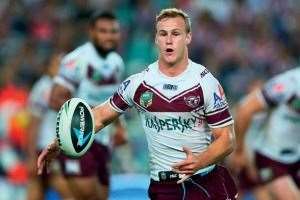 Manly magician Daly Cherry-Evans' bag of tricks is deep. Photo by Getty Images
Manly magician Daly Cherry-Evans' bag of tricks is deep. Photo by Getty ImagesHe’s already wearing his Manly shorts and a light-grey training tee courtesy of his sponsor Nike. He looks more like a runner getting some kays in before work than a footy star, which could be why none of the street’s cafe set recognises him – guess they prefer frappe to footy. Because Cherry-Evans is the man around here. Since making his NRL debut in 2011, his career has shot past the moon and kept on rocketing, if winning a premiership in your first year can be bettered. He claimed the Dally M Rookie of the Year gong just before that GF, and a week or two later was on the plane to Britain hoping to make his Test debut for Australia in the Four Nations tournament against Wales, New Zealand and England. Australia lapped the Welsh 56-14 on Daly’s debut, the 22-year-old among the try scorers. Oh yeah, that year he was crowned the best halfback in the world by the planet’s rulers of rugby league, too.
Two days ago, Cherry-Evans’ Sea Eagles narrowly beat their old rivals the Parramatta Eels at Brookvale Oval. Footballers carry the relief, as well as the elation, of a win for several days. Daly is still wearing his. He’s bolt-upright, with his core already steeling itself for the next hurdle – Manly’s first field session of the week – immediately after our chat.
Today there are no remnants of some of the funky ’dos he’s famous for parading, when his scalp is heavily shaved in some spots but shows his schoolboy-blond locks in others. Nor were they there the night he and his young Manly halves partner, Kiwi Kieran Foran, officially opened the NRL season in 2012 at a function outside the Sydney Football Stadium. “That was a very nervous moment for me; a very proud moment,” Cherry-Evans recalls of chatting to the voice of rugby league, Channel Nine’s Ray “Rabbits” Warren, on the event’s podium in front of a groovy, hushed audience. “The NRL had put a lot of faith in Kieran and me as up-and-coming rising stars. I guess we were what they saw as nice young faces to lead the NRL forward. To be painted in such a nice way by the NRL was obviously very kind of them. Hopefully Kieran and myself have since repaid them with some good football.”
Eighteen months later, Cherry-Evans was on another podium, this time at ANZ Stadium accepting the Clive Churchill Medal as Man of the Match in the 2013 grand final. He became just the third losing grand finalist to receive the coveted award after Canberra’s Brad Clyde claimed it in 1991 and Dragon Brad Mackay in 1993. Cherry-Evans was out of his skin with appreciation at having been named the award’s acceptor, but admits it did very little to ease the pain of Manly’s gruelling title-deciding loss to the Sydney Roosters. “It didn’t and it never will,” he says. “It was definitely one of the most uncomfortable positions I’ve been in. You know, we’d just been through the heartache of losing the biggest game of the year. But in saying that, I understand how prestigious the award is and what an honour it is to win it. Some very big names had received that award in previous years.”
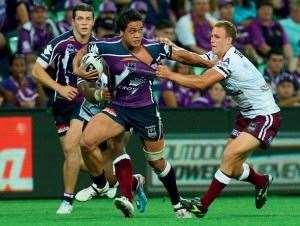 Tackling the reality - and intensity - of the NRL on debut in 2011. Photo by Getty Images
Tackling the reality - and intensity - of the NRL on debut in 2011. Photo by Getty ImagesSo what’s all this fuss over “DCE” about, anyway? Plenty of skilful, confident young number-sevens have come along before him. One of them was Peter Sterling, who in 1981 won a premiership with Parramatta, becoming the youngest halfback to win a GF – an accolade he held until Cherry-Evans’ win with Manly in 2011. “He’s got the complete game, to be honest,” Sterling tells Inside Sport. “I like the fact he’s a half that goes to the line and just plays what’s in front of him. He’s got a good running game; he’s very deceptive in attack. I also enjoy how often he uses his terrific upper-body strength. He kicks well, he obviously thrives in the combination he’s built with his five-eighth Kieran Foran. There’s no ego with them. They’re always doing what’s best for the team, always going to the line.”
The Channel Nine commentator and host of respected Fox Sports rugby league panel show, Sterlo, admits to not knowing a great deal about the young Queenslander before his arrival on to the NRL scene in ’11. “I must say, early on I didn’t realise how good a player he really was. At Manly at the time, there wasn’t what you could call a bolt-from-the-blue player, unlike, say, Luke Brooks at the Wests Tigers at the moment, who people have been expecting for a while now to reach and excel in first grade. Daly wasn’t a player who was in the development systems down here in Sydney, where you get to games early and see who’s coming up through the grades.”
This ball-running caper of Cherry-Evans’ is appreciated by another of those blond-haired, skilled halves to arrive before DCE, 2UE radio host and ’70s and ’80s Manly legend John Gibbs. “He’s got a good blend; plenty of tricks in his bag,” says Gibbsy of the only number seven to clock up double figures for tries (11), try assists, line-break assists and linebreaks in 2013. “My way of thinking is that a great halfback has to be a runner of the ball – and Daly’s such an elusive runner. In fact, the elusive running part is something he could develop even further. But he certainly threatens the defence in more ways than just running. He has a good kick and a good pass, too.”
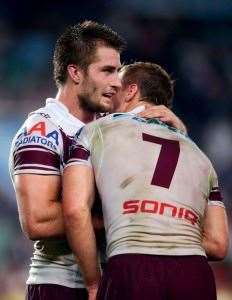 A quiet "well done, brother" from his halves partner Kieran Foran after toppling the Chooks in round four. Photo by Getty Images
A quiet "well done, brother" from his halves partner Kieran Foran after toppling the Chooks in round four. Photo by Getty ImagesIn rugged characters like Glenn Stewart, Anthony Watmough and Justin Horo, Cherry-Evans certainly has the ideal forward pack at Manly to retreat behind if required, but he shares the engine room’s hunger to keep the Sea Eagles moving downfield. In 2013, he averaged 22 tackles a game, too – a ridiculously high count for a halfback. Maybe he’s a prop trapped in a half’s body? “I notice myself that I run the ball a bit more than other halfbacks,” he says. “That’s obviously a preconceived idea of myself going into a game. I know I need to be the best I can and I believe running the ball is the best thing for my team, whether that’s by opening up gaps for the others later on in the game because of the attention drawn to myself ... I am a halfback; I’m not a back-rower. I shouldn’t be running every time I touch the ball. And that’s not what I do, obviously. I need to make sure as well that I’m feeding the ball to the right team-mates when the time comes ... ”
********
DALY CHERRY-EVANS can’t remember his first-ever game of footy, as a five-year-old in the northern Queensland rugby league stronghold of Mackay. Up there, every Saturday is a virtual rugby league carnival, with all grades of the city’s junior association, from the under-7s to under-16s, converging on the same set of fields. “Every Saturday, you can imagine, there were about eight different clubs in Mackay. So that’s eight clubs with at least eight or nine teams playing. It makes for a pretty big day. I think everyone has a common ground as far as rugby league goes in Mackay; whether you’re playing in an official game, or on one of the spare fields out the back, or just kicking a footy around with your mates getting ready for your game. It’s a lot of footy and a lot of fun as a kid.”
Back then, Cherry-Evans club-hopped between the Sarina Crocodiles, Souths Sharks and Mackay Brothers. Not to be a winner – it wasn’t as if one club handed around better oranges at half-time than the others. “At that age, I just wanted to play amongst my friends. If my mates changed teams, or I had one friend in one team and another in another, we’d rally together to try to get our parents to put us in the same team.”
Cherry-Evans’ dad is Troy Evans, a hardman for Norths Devils and Redcliffe Dolphins in the ’80s and ’90s. Naturally he was in the developing Daly’s ear a lot – mainly sharing lessons in competitiveness rather than combativeness. “Dad was known as not only one of the tougher players, but also one of the more ... I guess ‘trouble-makers’ on the field. He always played with his heart on his sleeve, but sometimes a little too outside the rules of rugby league. He would always want me to be competitive. And to be happy with what I’m doing. If I’m doing what I’m happy with, and also giving the best I can, I think that’s what any parent wants their kid to do.”
According to the widely accepted narrative, Cherry-Evans, as talented as he was as a 20-year-old, was turned away by club after club because of his diminutive stature. Then, magically, at the 11th hour, Manly decided to give him a go in first grade and the rest is history. It’s very romantic – what an amazing return from what could’ve been a career wasted! Cherry-Evans hates to ruin a good story with fact, but stresses the real version was a lot less dramatic. “It’s a bit of a myth, to be honest, of how I developed into a first-grader,” he says. “I got an opportunity to play at an NRL club in the Under-20s. I played two years of that. The next year I wasn’t in line for a first-grade start at Manly, so I was kept in reserve grade, which at the time was with the Queensland Cup side Sunshine Coast Sea Eagles, who had an affiliation with Manly. From there I had a reasonably good year, enough to prove that I was worthy of a start.”
So Cherry-Evans was good enough to play at NRL level after all. It’s just that Manly had an embarrassment of riches at halfback, with veteran Matt Orford steering the ship and youngster Trent Hodkinson next in line. “So the story of my journey to first grade isn’t as dramatic as everybody says. It’s a bit of a media beat-up in terms of the ‘hardship’ I had to face before playing first grade. I wasn’t the first and I won’t be the last to go through the development systems. In hindsight, I think it’s the best way to get your NRL start. Develop through the junior grades, develop through reserve grade and then take the opportunity in first grade when it arises.”
Hodkinson departed for Belmore at the end of the 2010 season, opening up the door for Cherry-Evans to make his debut in the opening round of 2011 alongside his good mate from their Under-20s days, Kieran Foran, who is actually Cherry-Evans’ junior by 18 months. “One of my more distinct memories from my first NRL game was kicking on the last tackle. Cameron Smith shot out of the line, as he does, to put pressure on the kicker and tackled me. He got to me extremely quickly. I can reflect back now on where I’d positioned myself on the field and realise it was just so wrong. I left myself vulnerable for someone like him to do what he does best. I remember thinking, ‘Wow, this is tough, these guys aren’t going to stop anytime soon – this is NRL.’ That was a sort of light-bulb moment where I knew I had my work cut out for me to get better each game, and that I had a lot to learn.”
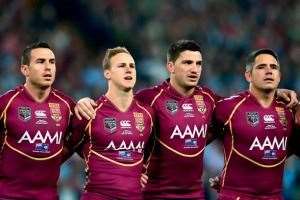 A different shade of Maroon, on Origin debut last year. Photo by Getty Images
A different shade of Maroon, on Origin debut last year. Photo by Getty ImagesJohnny Gibbs was watching that night, too. “That first match, when he made his first grade debut, I sat down to watch the footy on TV. And I have got to say, it gave me a bit of a jolt. I thought, ‘Gee, that’s me!’ I think it’s his bolt-upright running style and the way he carries his head. And the blond hair, you know. And he’s the Manly number-seven. When I saw him, it was quite eerie.”
He’s off-contract at Manly at the end of next season. And the closer Cherry-Evans gets to deciding if the dream halves pairing of the NRL continues or ends, the more media interest there’ll be in the LeBron Decision-type announcement. “There’s no pressure on me personally to make a decision,” he says. “It’s a difficult one because there’s always going to be media speculation and that’s really unfortunate, because most of the time they don’t know the cold, hard facts of what’s going on,” he offers. “So I need to continue to not worry about the media and the pressures they’ll be putting on for certain decisions to be made. I just need to focus on playing good football, rewarding Manly for keeping me at the club for this long. From there, if I continue to play good football, then I’m sure my decision will make itself. A decision for me doesn’t have to come soon, nor will it.”
********
IN A GAME mostly about showcasing personal strength and stamina, there’s no dirtier term than that ugly word starting with “b” ... The only way Daly Cherry-Evans will ever see any bench time at Manly is if he succumbs to a mid-match injury, or he’s replaced during the dying stages of a Sea Eagles no-contest. At representative level, however, “bench” is music to Cherry-Evans’ ears. He’s mature enough to realise that being second in line to two of the best players in the history of rugby league is no mean feat and that it places him in stellar company.
It could be a long wait as far as a regular starting role in either the Australian or Queensland teams for Cherry-Evans is concerned. Firstly, 31-year-old Johnathan Thurston signed on for four more years at the North Queensland Cowboys in 2013, while Cooper Cronk, 30, did the same at the Storm in 2012. With Queensland two years away from rounding out a perfect ten series of Origin dominance, who could blame either for wanting to hang around in the starting side to enjoy that kind of milestone?
Not Cherry-Evans, that’s for sure. He’s more than happy to drink in the experience and knowledge from the two greats. A bench spot for Queensland, earned last year during two appearances for the Maroons, will do him just fine. “It’s definitely not frustrating,” he beams. “I guess the picture that’s been painted lately is that I’m ready to be able to start right now, but I know for me to be able to develop into the player I want to be, I need to continue to learn off these players that are ahead of me. And with that comes biding my time on the bench. I
have no frustration whatsoever sitting behind these wonderful players, hopefully learning as much as I possibly can. So that if the time comes for me to get a starting opportunity, I’ll reward their advice and kindness for the opportunity.”
Footy fans back home who were willing to sacrifice a few hours of weekend sleep late last year were rewarded with the next chapter in the inevitably brilliant Australian rep career for Cherry-Evans. Selected in coach Tim Sheens’ squad as support to Thurston and Cronk, Cherry-Evans clocked up four appearances for the Kangaroos during last year’s Rugby League World Cup in Britain. “As much as it was written up in the media back here, fortunately I was on the other side of the world, so I wasn’t reading or hearing about this,” he remembers of the Australian league community’s gushing reaction to his role in Australia’s pool floggings of Ireland and Fiji. “So all I felt I was doing was taking advantage of an opportunity I was given. At that time, Tim was kind enough to rotate us three halves around the three pool matches, which in turn gave me two starting opportunities. I understood what this could possibly mean, and that was: play well enough while I’m in the side, and it would be hard to leave me out. I knew that. That was my goal – to play extremely well, so that he wouldn’t leave me out when the semi-finals started.
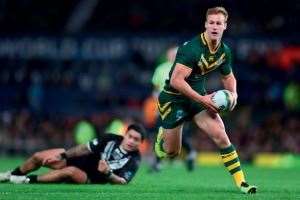 Leaving him out of Australia's squad for the Rugby League World Cup final was out of the question for coach Tim Sheens. Photo by Getty Images
Leaving him out of Australia's squad for the Rugby League World Cup final was out of the question for coach Tim Sheens. Photo by Getty Images“Fortunately enough for me, it resulted in me staying in the side and coming off the bench in the final, which I was more than happy to do. The Australian team is obviously one of the best sides assembled that I can remember in recent times. Just star-studded,” Cherry-Evans glows. “There are blokes whose names are not going to be forgotten any time soon. For me to play a small role in that side at the World Cup was such a humbling moment. It only takes a single tour or a week in Origin for me to know that I have so much to learn from the likes of Thurston, Cronk, Slater, Smith and Inglis.”
It’s hard to imagine, but easily forgotten, that once upon a time in their careers, they were benchwarmers, too.
Related Articles

Feature Story: Moving the Needle

The Aussies at The Open













